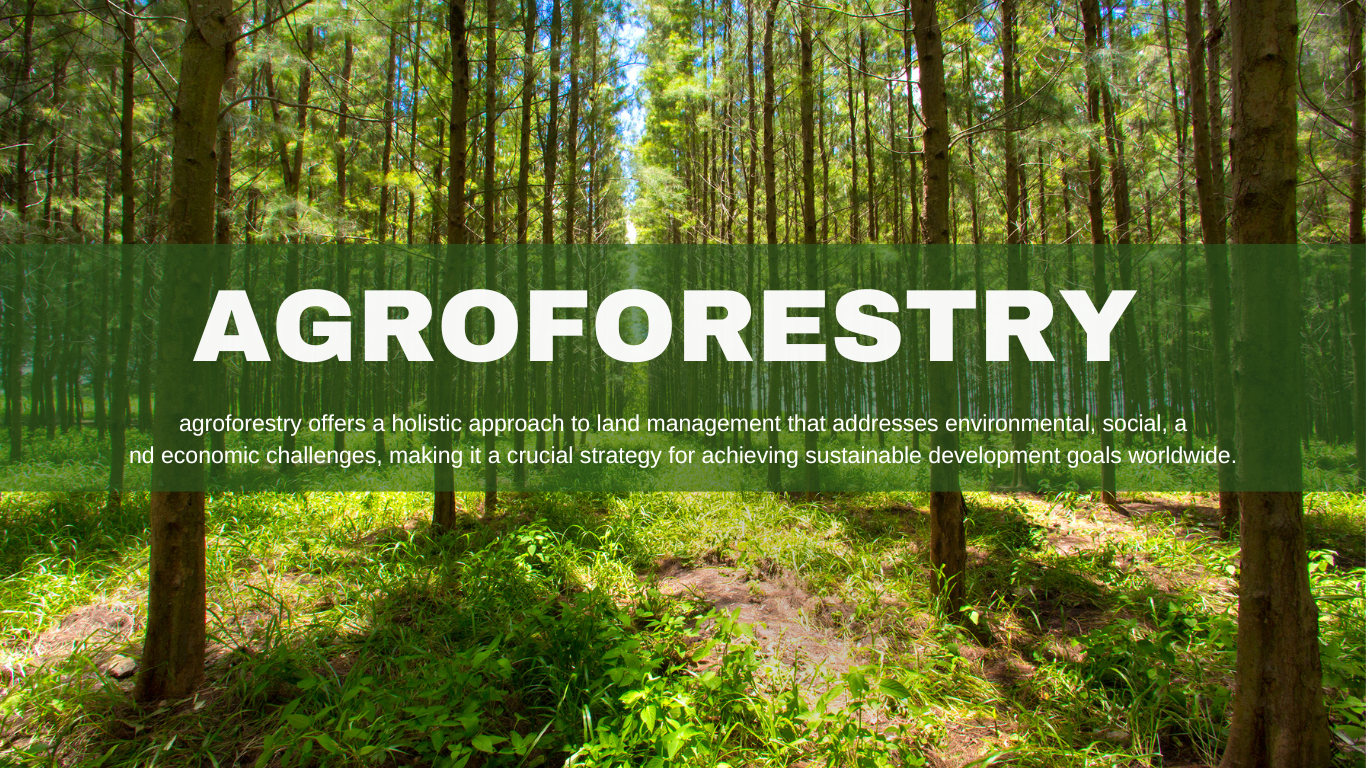

Agroforestry: Nature's Duet of Trees and Fields
Agroforestry: Nature's Duet of Trees and Fields
Growing Green Futures: Agroforestry Uniting Land and Life
Introduction:
In the tapestry of sustainable land management practices, agroforestry emerges as a captivating symphony where agriculture and forestry harmonize to create a melody of ecological and economic benefits. Imagine a landscape where crops and trees intertwine, each playing a vital role in nurturing the land, enriching communities, and sustaining livelihoods. Welcome to the world of agroforestry, where nature's orchestra performs its timeless dance of growth and abundance.Agroforestry can become an important tool to build resilience of farmers and rural people against threats of climate change and natural calamities. Farmers have been growing trees on their farms for generations to maintain healthy soil and secure food supplies and for timber and fuel. But the practice of agroforestry has been declining sharply in India in the past few decades.
Understanding Agroforestry:
Agroforestry, also known as forest farming or ago-sylviculture, embodies a holistic approach that integrates trees with crops or pasture. It goes beyond conventional farming methods by embracing the synergies between agricultural and forestry practices. In agroforestry systems, trees and crops coexist, complementing each other's growth patterns, resource utilization, and ecological functions.
1.
Environmental Harmony
Agroforestry stands as a beacon of environmental harmony, seamlessly
integrating trees into agricultural landscapes to promote sustainability and
ecological balance. By preserving forest integrity and enhancing land
productivity, agroforestry systems contribute significantly to environmental
conservation and resilience.
Preservation of Forest Integrity Agroforestry practices help maintain forest cover by incorporating trees into agricultural areas, thereby reducing deforestation pressure on natural forests. This preservation of forest integrity is critical for safeguarding biodiversity, protecting wildlife habitats, and maintaining ecosystem services.
Carbon Sequestration Trees play a
crucial role in mitigating climate change by sequestering carbon dioxide from
the atmosphere through photosynthesis. Agroforestry systems, with their
extensive tree cover, act as carbon sinks, storing carbon in both aboveground
biomass and soil organic matter, thereby helping to mitigate greenhouse gas
emissions and combat global warming.
Soil Conservation The presence of trees in
agroforestry systems helps prevent soil erosion by stabilizing slopes, reducing
water runoff, and enhancing soil structure. Tree roots bind soil particles
together, preventing erosion caused by wind and water erosion, while leaf
litter and organic matter contribute to soil fertility and moisture retention.
Biodiversity Enhancement Agroforestry landscapes support a rich
diversity of plant and animal species by providing varied habitats, food
sources, and shelter. The combination of trees, crops, and understory vegetation
creates ecological niches that support a wide range of flora and fauna,
including beneficial insects, birds, mammals, and microorganisms, thus
enhancing biodiversity conservation efforts.
2. Economic Gains
The
economic benefits of agroforestry are manifold, offering farmers diversified
income streams and enhanced livelihood security through the sustainable
management of trees and agricultural crops.
Diversified Income Streams Agroforestry systems provide farmers with multiple revenue sources beyond traditional agricultural yields. Trees cultivated for timber, fruits, nuts, medicinal plants, and other non-timber forest products offer valuable income opportunities throughout the year, diversifying farm revenues and reducing dependence on single crops or commodities.
Timber
and Non-timber Forest Products Agroforestry allows farmers to capitalize on the
market demand for timber products such as lumber, poles, and fuelwood, as well
as non-timber forest products like fruits, nuts, resins, essential oils, and
medicinal plants. These products fetch higher prices than conventional crops
and provide additional income streams for farmers.
Enhanced Market Opportunities Agroforestry
products often command premium prices in niche markets due to their perceived
quality, sustainability, and environmental benefits. Farmers engaged in
agroforestry can tap into these lucrative markets, capitalize on consumer
demand for organic, eco-friendly products, and access value-added processing
and marketing opportunities.
3. Social Connection
Agroforestry fosters social connection and community resilience by
promoting inclusive decision-making, collaborative land management, and shared
resource governance.
Respect for Local Traditions Agroforestry practices respect local traditions, cultural values, and indigenous knowledge systems, integrating traditional land use practices with modern agricultural techniques. By preserving cultural landscapes and heritage sites, agroforestry strengthens the social fabric of communities and promotes intergenerational knowledge transfer.
Community Empowerment Agroforestry empowers
local communities by involving them in land management decisions, resource
allocation, and income-generating activities. Participatory approaches to
agroforestry planning and implementation ensure that community needs and
priorities are addressed, leading to greater ownership, engagement, and social
cohesion.
Shared Benefits and Responsibilities Agroforestry encourages collective action and cooperation among farmers, landowners, and stakeholders, fostering mutual support networks and shared responsibility for landscape management. By working together to address common challenges such as soil erosion, water scarcity, and climate variability, communities build resilience and solidarity, strengthening their capacity to adapt to change.


Types of Agroforestry Systems:
Farm Forestry: Farm forestry is a land management
approach where farmers integrate trees into their agricultural landscapes
alongside crops or pasture. The primary objective of farm forestry is to
cultivate trees for various purposes such as timber, fruits, firewood, or other
products while maintaining agricultural productivity. This approach allows
farmers to diversify their income sources, increase farm resilience, and
promote sustainable land use practices.
Key Characteristics:
Tree
Integration: Trees are
strategically planted within agricultural fields or along field margins to
maximize land productivity and utilize available resources efficiently.
Diverse Tree
Species: Farmers often select a mix of
tree species suited to the local climate, soil conditions, and market demand.
These may include fast-growing species for short-term benefits and
slower-growing species for long-term timber production.
Multiple
Benefits: Trees in farm
forestry systems provide a range of benefits, including timber for construction
or fuelwood, fruits for consumption or sale, shade for livestock or crops, and
ecosystem services such as soil conservation and biodiversity enhancement.
Benefits:
Diversified
Income: Farm forestry diversifies
farmers' income sources beyond traditional crop production, providing
additional revenue streams from tree products.
Enhanced
Resilience: Trees
contribute to the resilience of agricultural landscapes by stabilizing soil,
improving water retention, and buffering against climate extremes such as
droughts or floods.
Sustainable
Practices: Farm forestry promotes
sustainable tree cultivation practices such as agroforestry, agroecology, and
silvopasture, which prioritize environmental conservation and long-term land
productivity.
Extension Forestry: Extension forestry involves
reforestation or afforestation initiatives aimed at reclaiming degraded or
barren lands and restoring them to productive ecosystems. This approach goes
beyond individual farm boundaries to address landscape-level challenges such as
soil erosion, deforestation, and habitat loss.
Key Characteristics:
Land
Rehabilitation: Extension
forestry focuses on rehabilitating degraded lands through tree planting, soil
conservation measures, and biodiversity restoration efforts.
Community
Engagement: It often
involves collaboration with local communities, government agencies, NGOs, and
other stakeholders to mobilize resources, raise awareness, and implement tree
planting programs.
Ecosystem
Restoration: Extension
forestry contributes to ecosystem restoration by reestablishing vegetation
cover, enhancing wildlife habitat, and improving ecosystem services such as
water purification and carbon sequestration.
Benefits:
Environmental
Restoration: Extension
forestry plays a vital role in restoring degraded ecosystems, mitigating soil
erosion, conserving biodiversity, and enhancing ecological resilience.
Watershed
Management: Tree planting initiatives in
watersheds help regulate water flow, reduce sedimentation, and protect water
quality, benefiting downstream communities and ecosystems.
Community
Empowerment: By
involving local communities in tree planting and land restoration activities,
extension forestry fosters community ownership, empowers marginalized groups,
and strengthens social cohesion.
Mixed Forestry: Mixed forestry integrates diverse tree species with crops,
pasture, or fodder grasses to create multifunctional landscapes that provide a
wide range of benefits. This approach maximizes the productive potential of
land while promoting ecological sustainability and resilience.
Key Characteristics:
Polyculture
Systems: Mixed forestry systems
incorporate multiple tree species along with agricultural crops, pasture, or
livestock, creating diverse and resilient agroecosystems.
Complementary
Plantings: Trees and crops are selected
based on their compatibility, nutrient requirements, and growth patterns to
optimize resource use and minimize competition.
Integrated
Management: Farmers
adopt integrated land management practices such as agroforestry, alley
cropping, or silvopasture to maximize the synergies between trees and
agricultural components.
Benefits:
Improved Soil
Health: Mixed forestry enhances soil
fertility, nutrient cycling, and organic matter accumulation, leading to
improved soil structure, water retention, and crop productivity.
Biodiversity
Conservation: By creating
habitat diversity and ecological niches, mixed forestry supports a wide range
of plant and animal species, contributing to biodiversity conservation and
ecosystem resilience.
Economic Viability: Mixed forestry diversifies income sources, increases farm profitability, and reduces production risks by combining tree products with agricultural commodities and ecosystem services.


"Shading the Future: Agroforestry's Shade-Grown Solutions"
The Dance of Trees and Fields:
Agroforestry embodies the graceful
dance of trees and fields, where each partner contributes to the symphony of
life. It's a choreography of roots delving deep into the soil, leaves reaching
for sunlight, and farmers stewarding the land with care and reverence. In
agroforestry landscapes, every element plays a vital role in nurturing
biodiversity, conserving natural resources, and sustaining vibrant rural
communities.
Conclusion:
As we immerse ourselves in the enchanting world of agroforestry, let us embrace the timeless wisdom of nature's duet. Let us cultivate landscapes where trees and fields dance in harmony, where abundance flourishes, and where the rhythms of life resonate with balance and resilience. Through agroforestry, we can co-create a future where agriculture and forestry converge to nurture the planet, uplift communities, and safeguard the legacy of generations to come.
Note : This research is based on google we are not responsible for any other circumstances.







